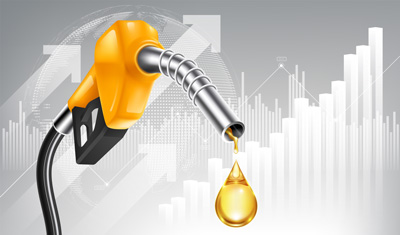 Let’s start with the obvious: Nobody likes high gas prices—especially the retailers selling gas.
Let’s start with the obvious: Nobody likes high gas prices—especially the retailers selling gas.
When prices are low, drivers are in a better mood, and they’re more likely to buy something inside the store, especially because they have extra cash. And expenses are lower. Swipe fees for credit cards average about 2.2%. When gas is $2 a gallon, those fees are about 44 cents for a 10-gallon fill-up. At $4 a gallon, those fees double to 88 cents.
Gas prices have been over $3 a gallon since May 2021, and they've been cited as a pocketbook issue in elections.
Pretty much everyone wants to see prices lower, and there’s been a lot of talk about the “good ol’ days” when gas prices were under $2 a gallon. Yes, gas prices had been very low a few times, but those weren’t good times. When oil prices drop dramatically, it’s because demand suddenly dried up—and it’s probably because something terrible happened.
Three times this century oil and gas prices plunged because of some large-scale calamity:
1. Global COVID-19 pandemic: In the spring of 2020, fuel demand cratered 40% almost overnight. Sharply reduced demand and a price war between Russia and Saudi Arabia send West Texas Intermediate oil futures to minus $37.63 a barrel in April. That’s right—demand was so soft that oil producers were paying buyers to take their product. Gas prices bottomed out the week of April 27 at $1.77.
2. Collapse of the global economy: After hitting a record $147 a barrel in July 2008, oil prices dropped to $32 in December because of the sudden global financial collapse that led to the Great Recession of 2008-09. Global demand for oil decreased for the second straight year—the first two-year decline since 1983. Gas prices bottomed out at $1.61 on December 29, 2008.
3. 9/11 terrorist attacks: Terrorists attacked the United States on September 11, 2001, prompting reduced air traffic. In turn, crude oil prices dropped significantly from nearly $28 per barrel on September 7 to $17.50 on November 15. Likewise, gasoline prices fell from $1.52 per gallon on September 10 to $1.06 on December 17, with many areas of the U.S. seeing gasoline prices under $1 per gallon.
However, there was one time this century in which oil and gas prices dropped for a reason other than a global calamity. By 2016, after several years of increasing production, particularly from the Bakken shale oil fields, the market was flooded with oil. That was one of the main factors that pushed crude prices down more than 50% in four months. And gas prices followed, dropping to $1.72 on February 15, 2016. This rise in production was quickly followed by a bust cycle—something that has happened with oil production since the discovery of oil at the Titusville well in 1859—and it took several years for the United States to recover.
While low gas prices weren't caused by a downturn in economic activity, it did ultimately lead to several lean years in the oil industry.
Huge decreases in demand push down oil prices. Meanwhile, huge decreases in supply—or concerns about supply—push up oil prices. And that’s what we saw in 2022 when Russia invaded Ukraine. Uncertainty over Russian oil production, which is one in 10 barrels produced worldwide, led to record gas prices of $5.02 in June 2022.
It's one of many examples when supply concerns pushed oil prices higher. Here are some others:
Colonial Pipeline malware attack (2021). A ransomware attack on the Colonial Pipeline caused a brief shutdown that resulted in gas prices reaching $3 a gallon for the first time since 2014.
Hurricane Harvey (2017). Three significant storms battered the United States in 2017, but Hurricane Harvey had the biggest effect on gas prices. The storm hit the Gulf Coast and reduced U.S. refining capacity by 34%. The storm also disrupted fuel distribution throughout the country, especially related to the Colonial Pipeline, and led to the second largest weekly gas price increase at the time (28 cents).
Arab Spring (2011). Uprisings in several oil-producing countries, notably Libya, lead to oil price spikes and gas prices topped out at $3.97 per gallon on May 9.
Small cuts have big impact (2008). Short-term production decreases from Mexico, Nigeria, Iraq, and the North Sea pushed oil and wholesale gas prices higher, which may have been abetted by a “fear premium” associated with rising prices from commodities traders. In mid-July, oil prices ($147 a barrel) and gas prices ($4.11 a gallon) hit record highs.
Elimination of MTBE (2006). Gasoline prices took off in April with the rapid elimination of MTBE as a fuel additive, rising more than 30 cents that month.
Hurricane Katrina (2005). Hurricane Katrina made landfall on August 29 and significantly disrupted the country’s petroleum infrastructure. Oil prices hit a record $70.85 per barrel on August 3, and wholesale gasoline prices also rose sharply. The average retail price of gas jumped a record 42 cents in one week.
Second Gulf War (2004). The start of the second Gulf War in March briefly caused oil prices to increase $10 a barrel overnight, but the short duration of the conflict quickly calmed markets, and gas prices dropped four cents a week later.
Venezuelan strike (2002-03). A strike in Venezuela that began in December 2002 deprived the United States of imported crude oil and refined petroleum product for several months. At the time, Venezuela supplied approximately 8% of total U.S. petroleum products. Gas prices shot up 36 cents between December and mid-March.